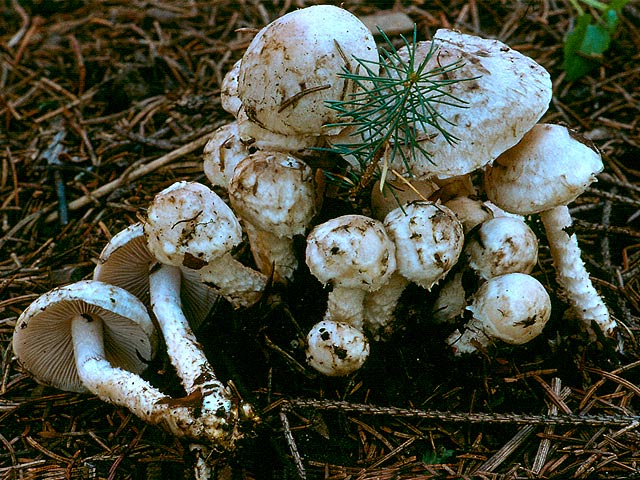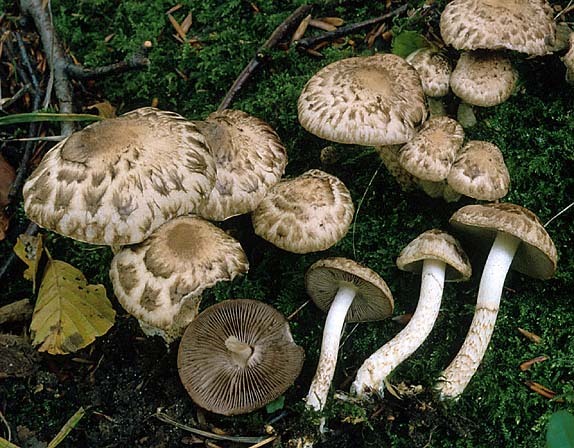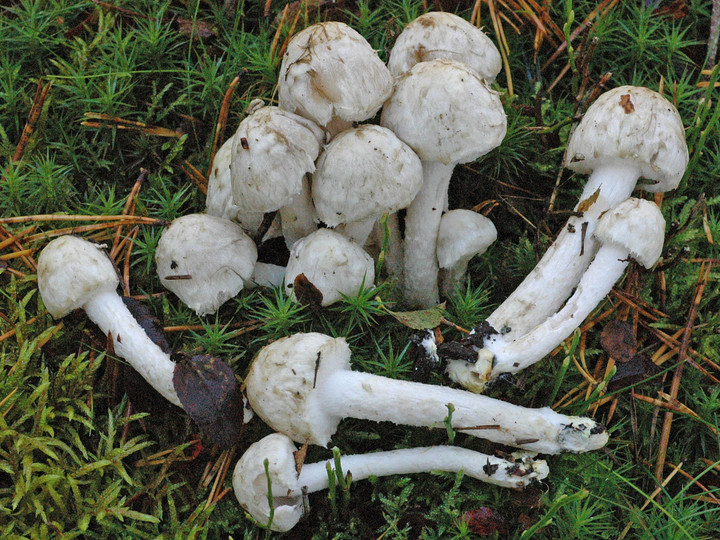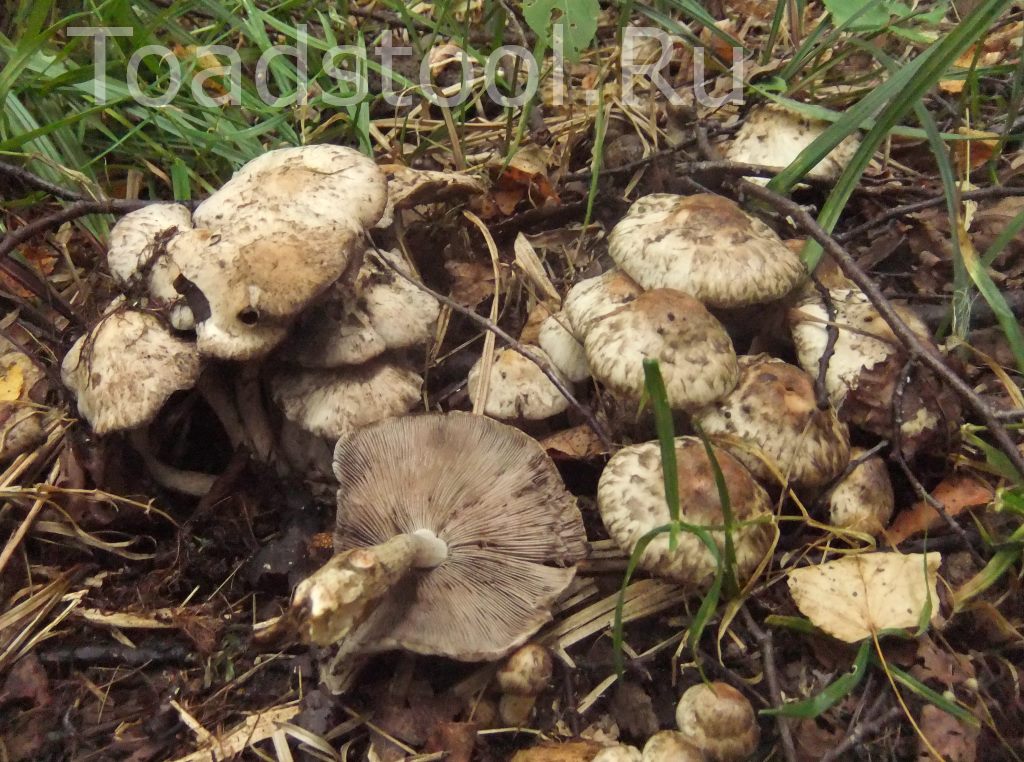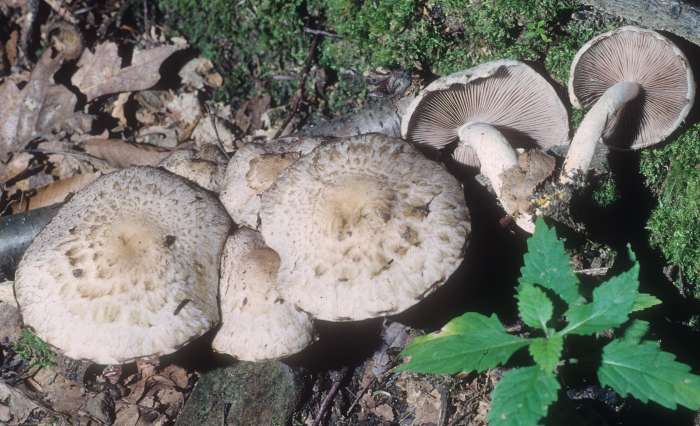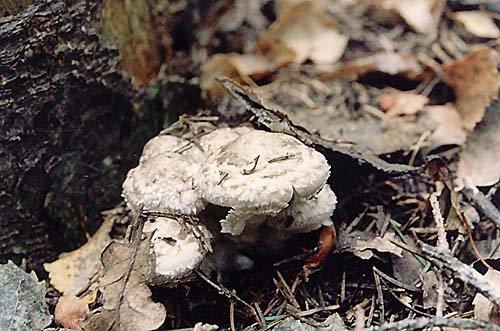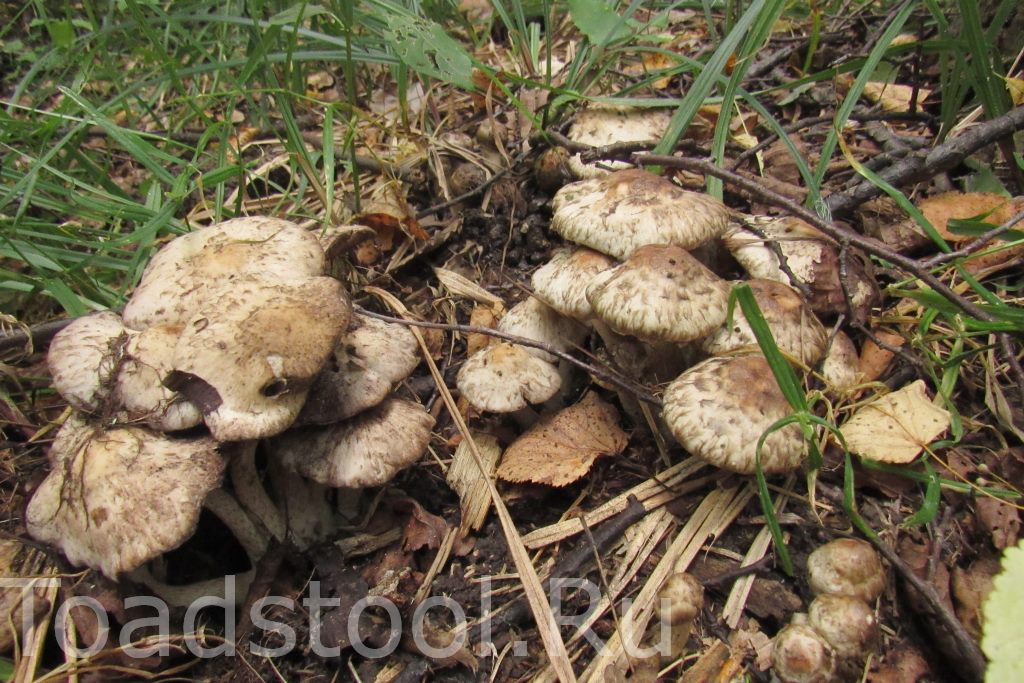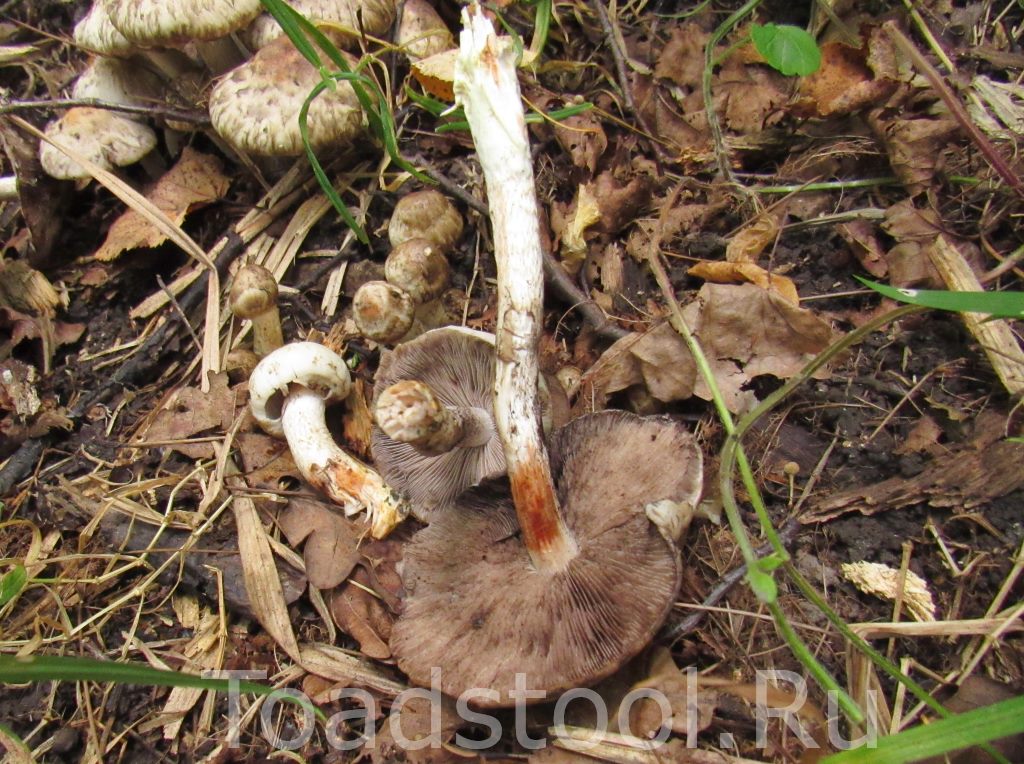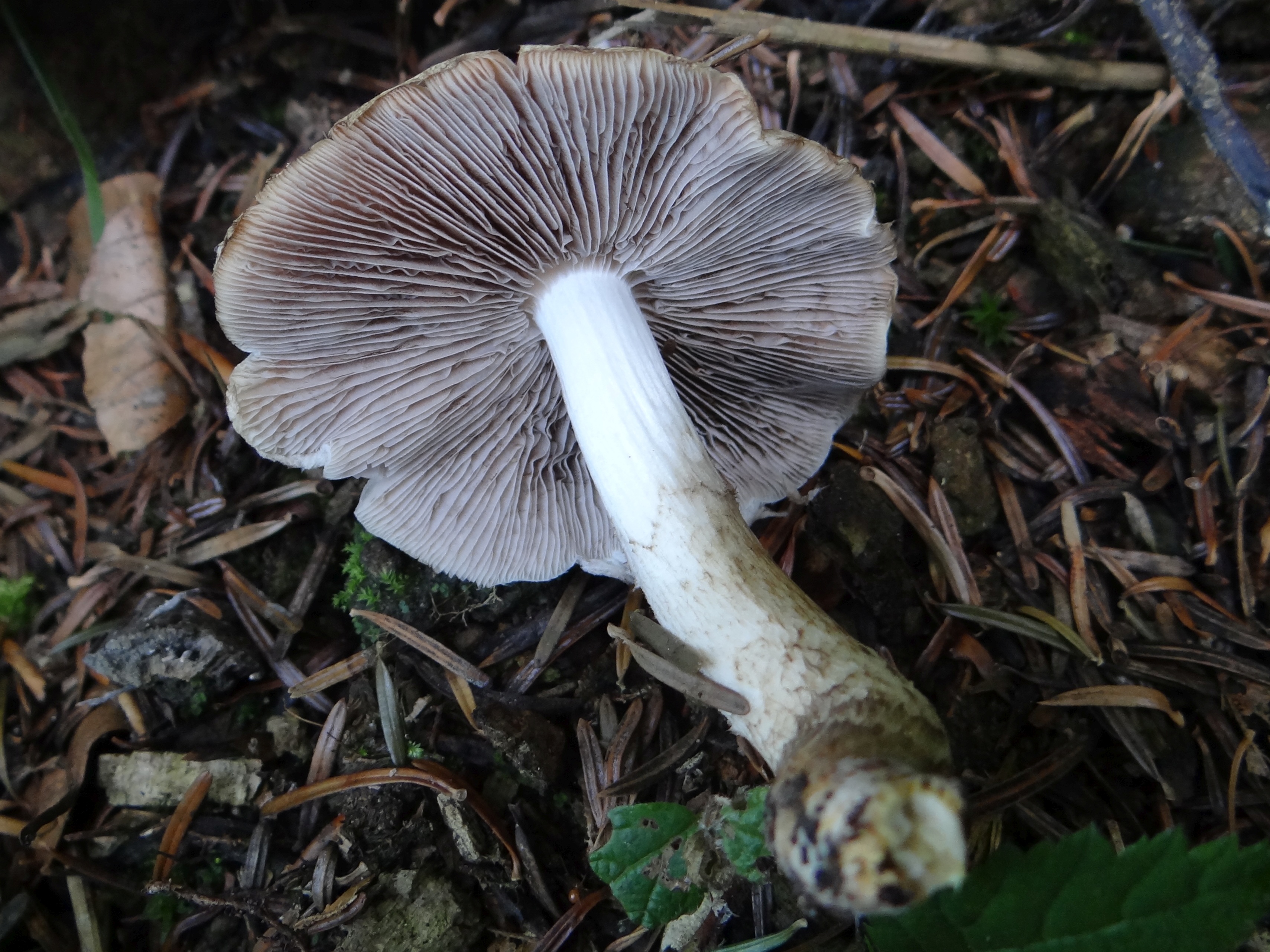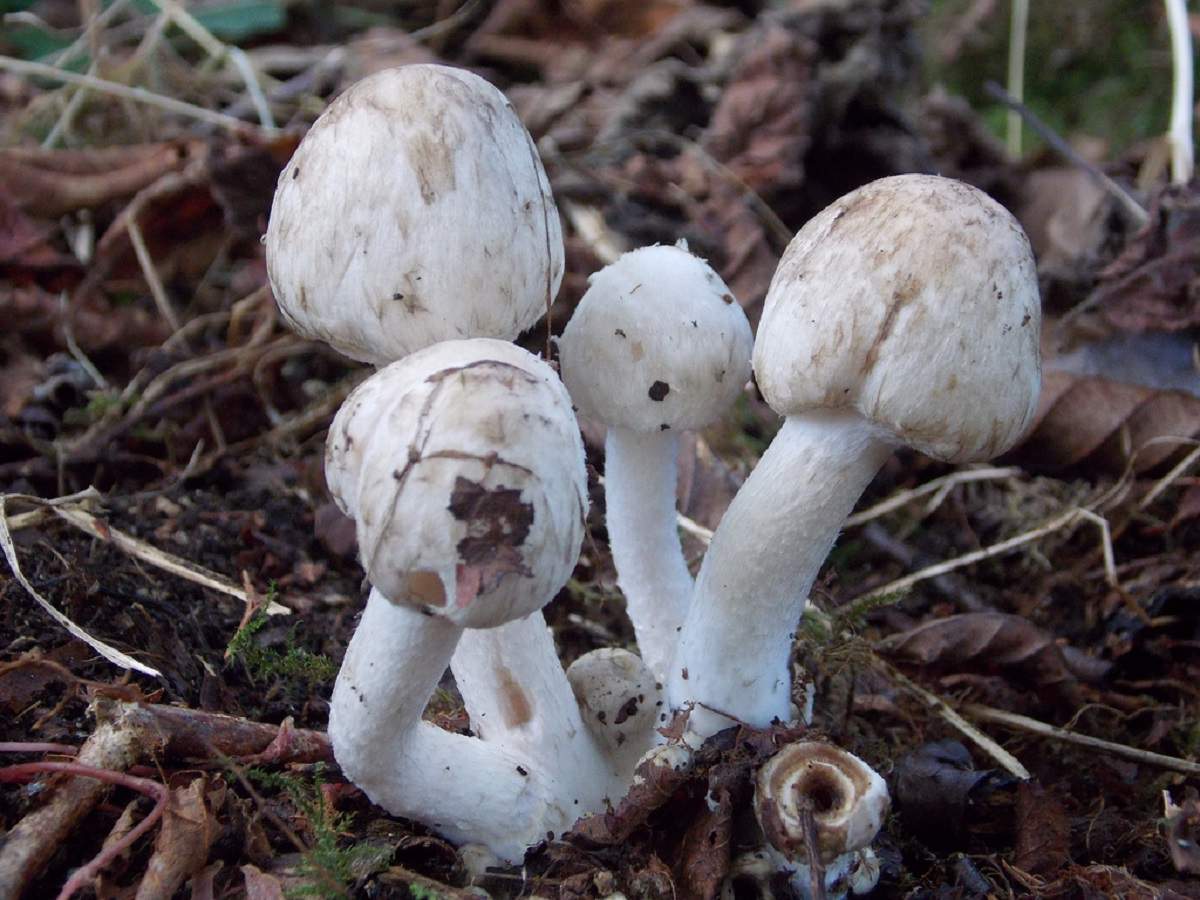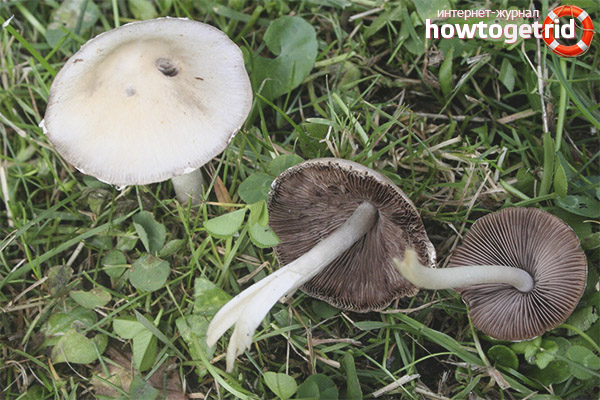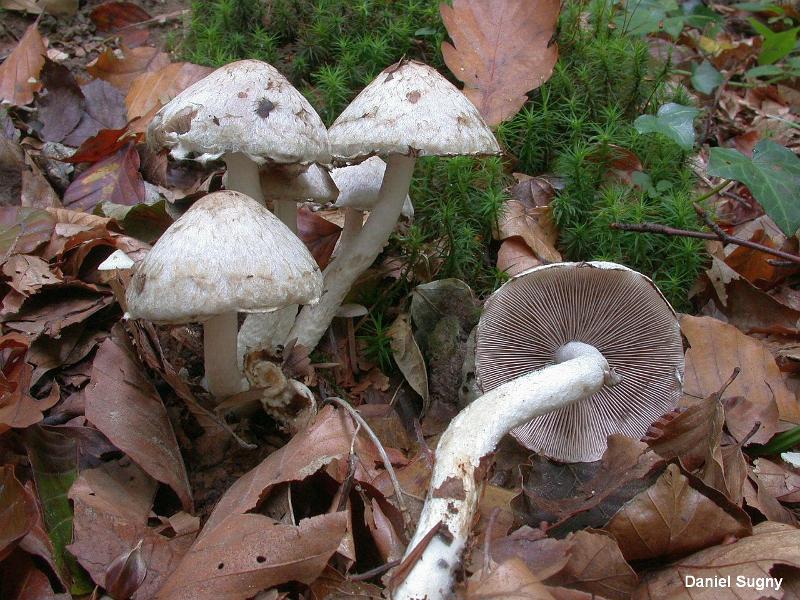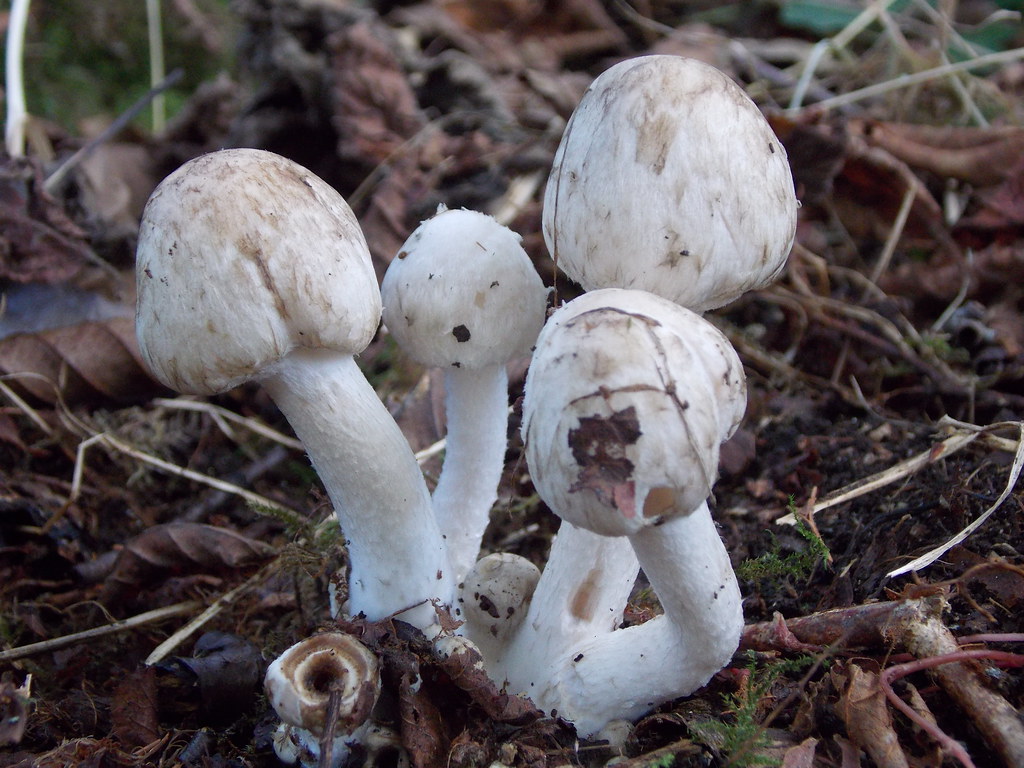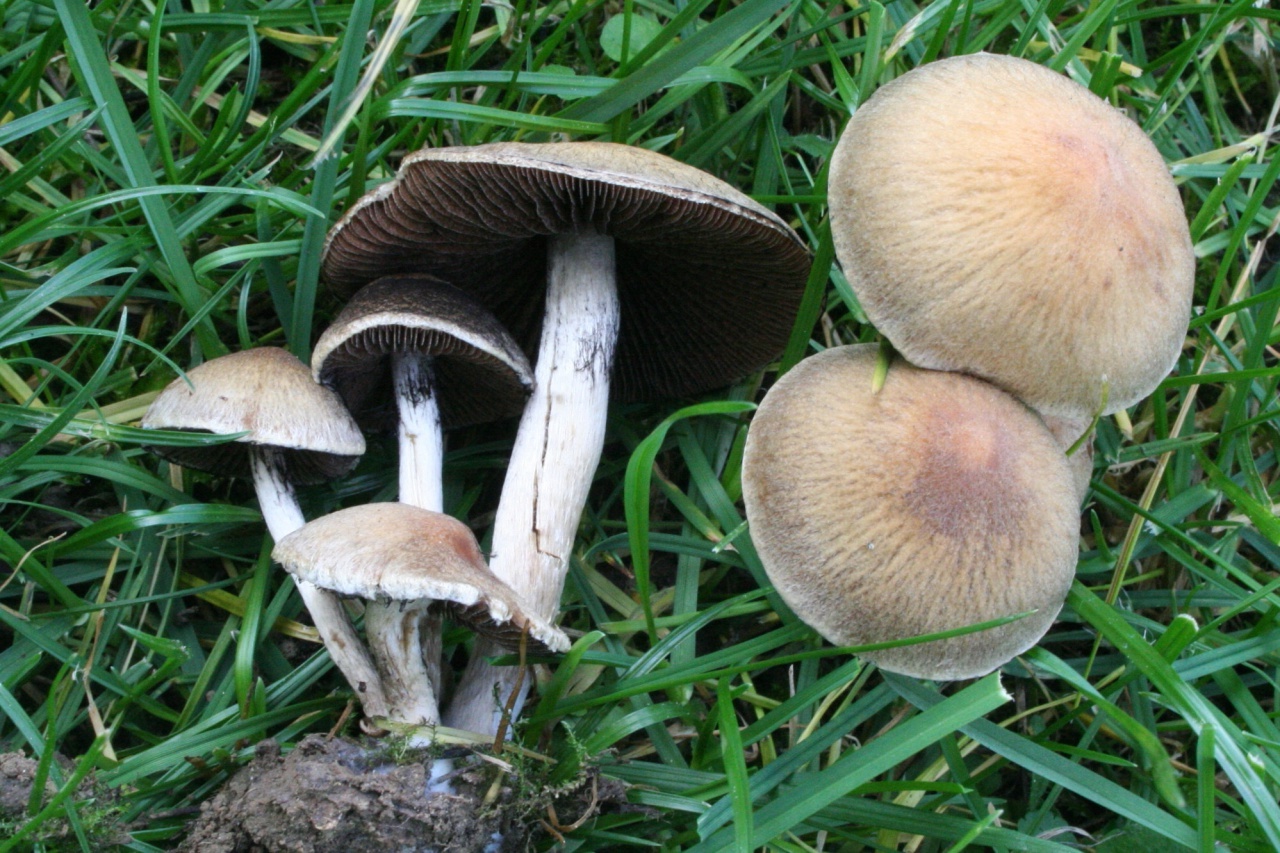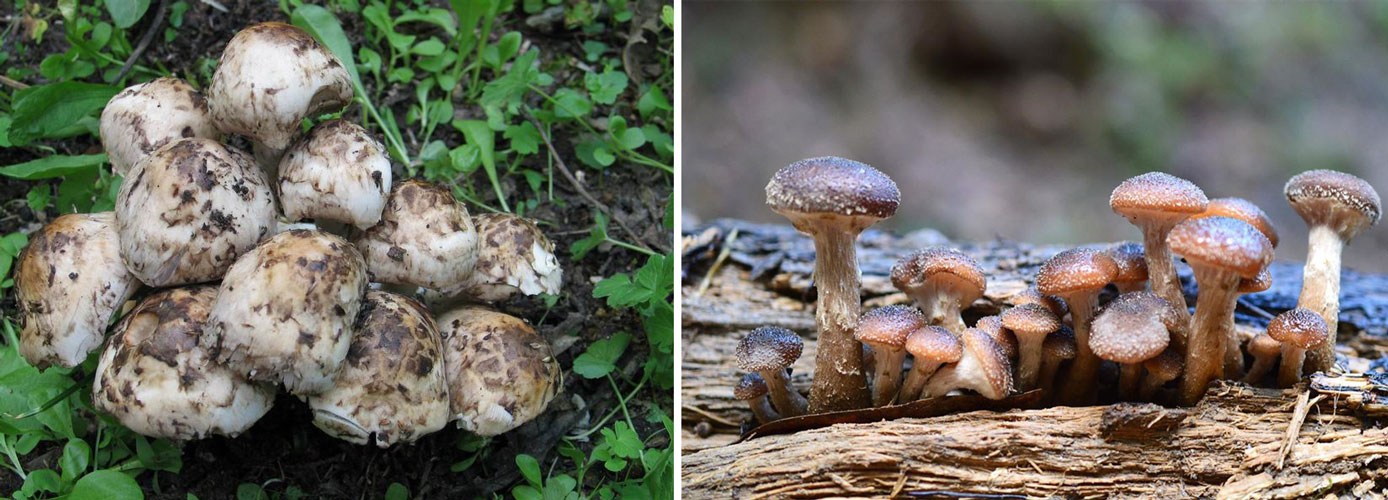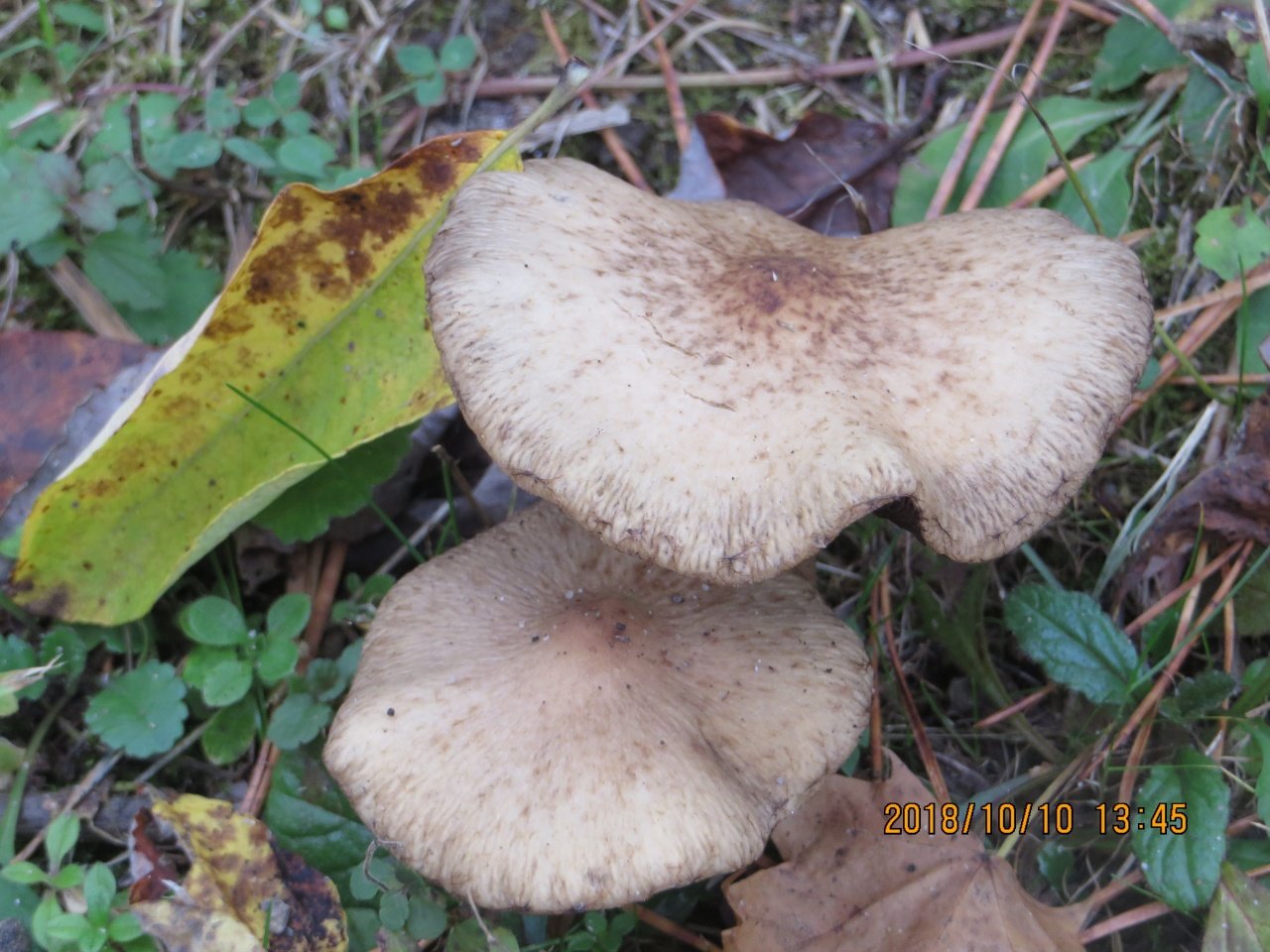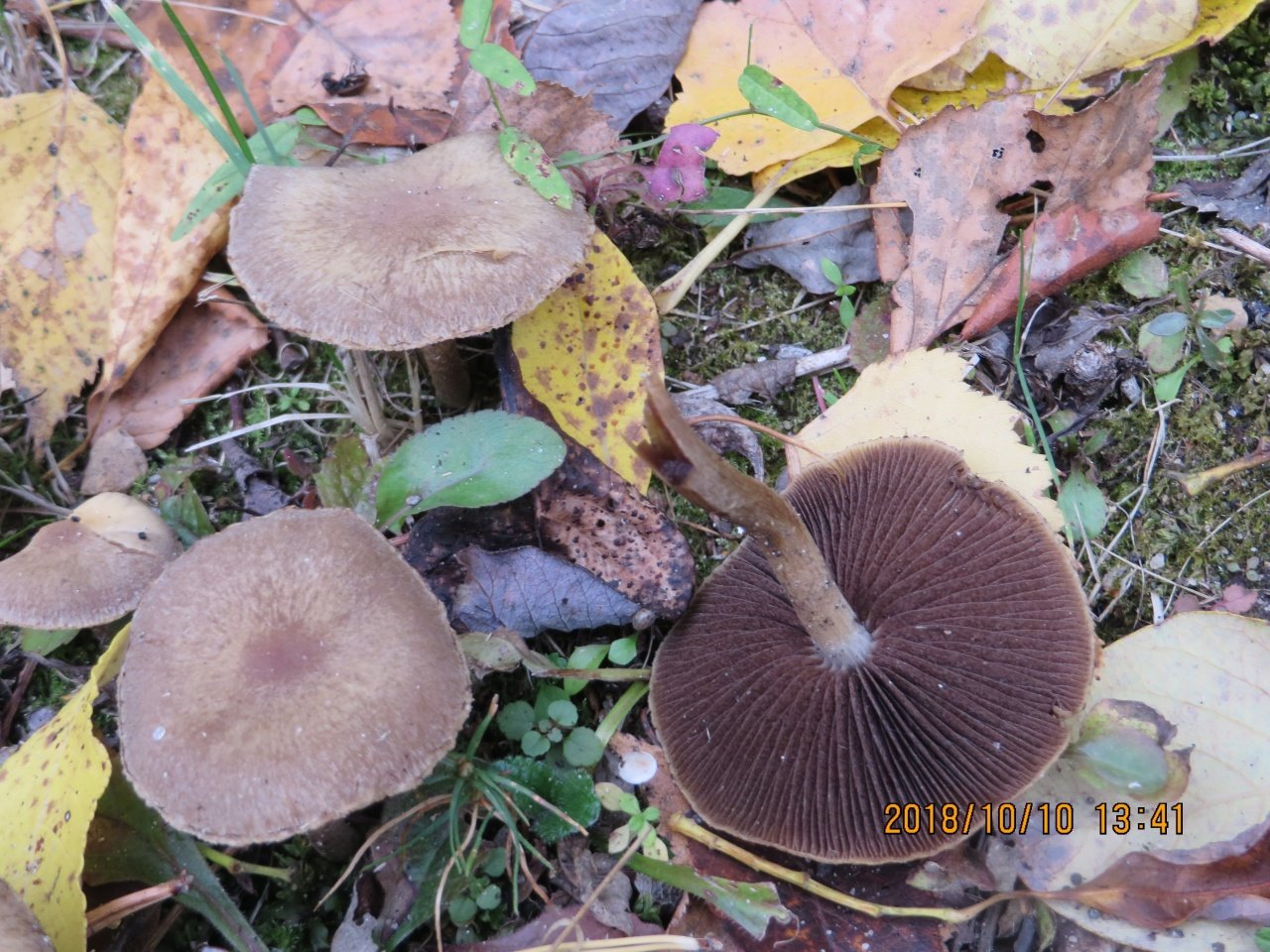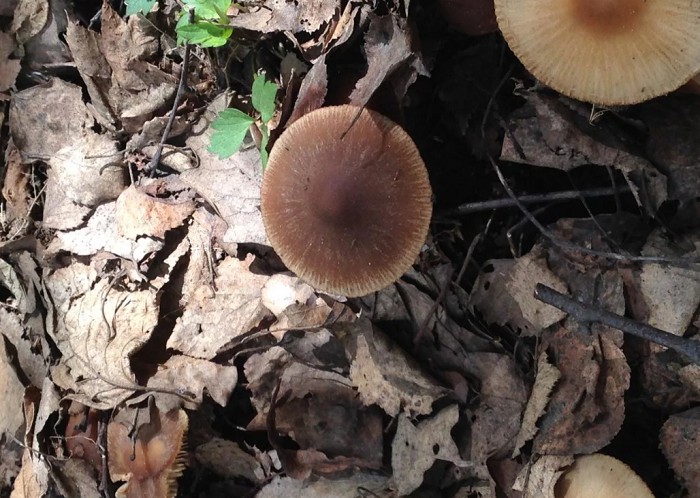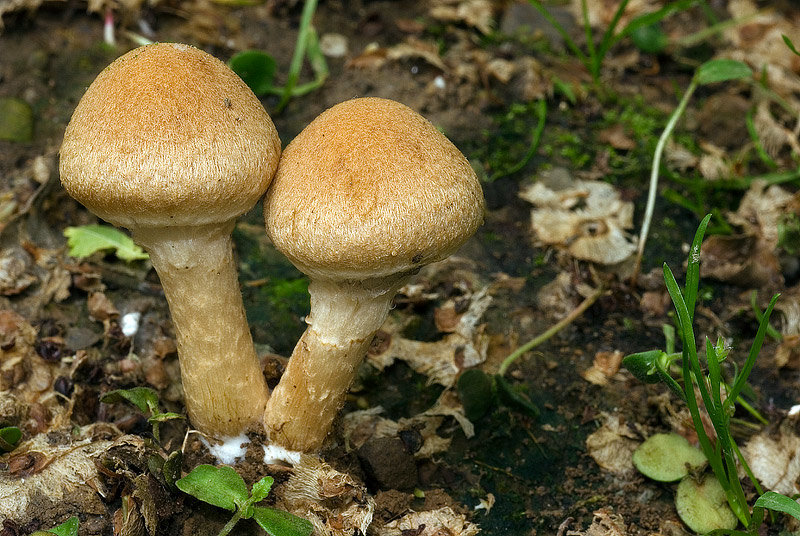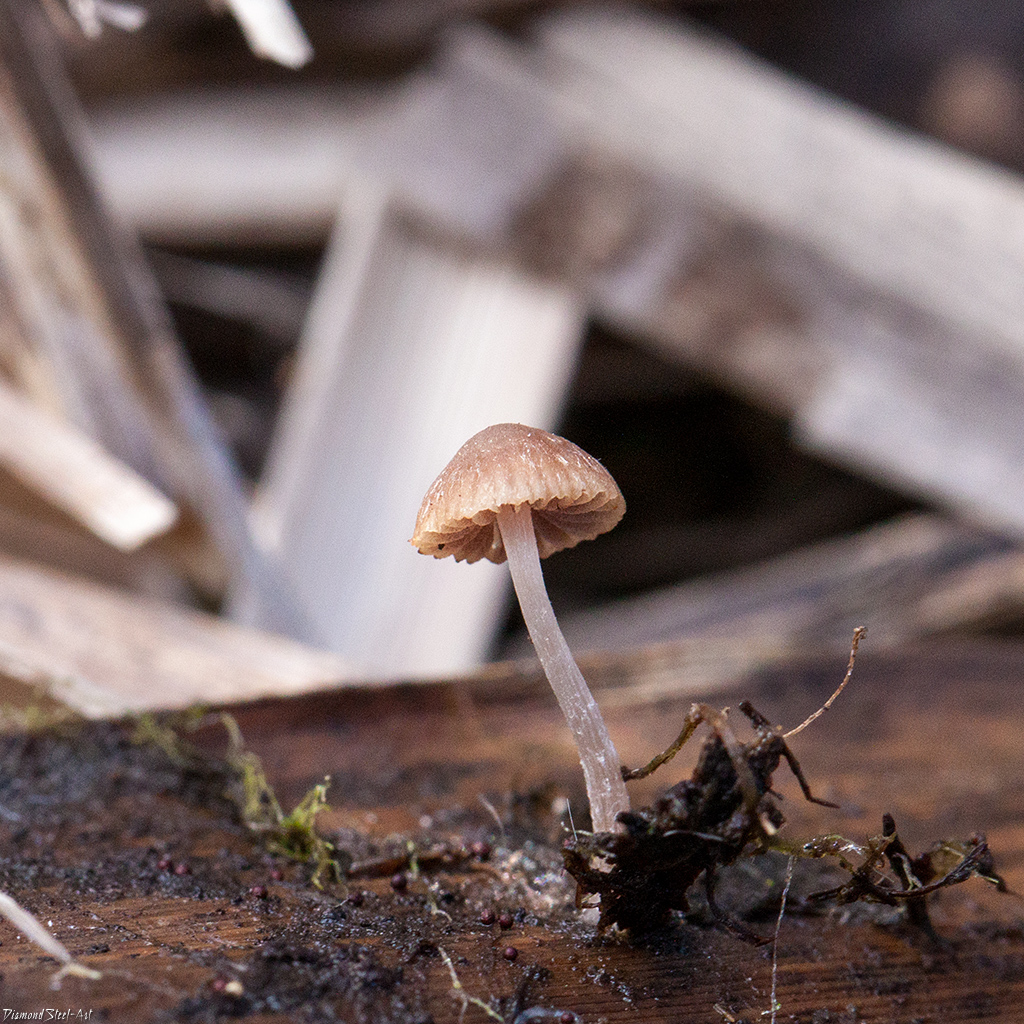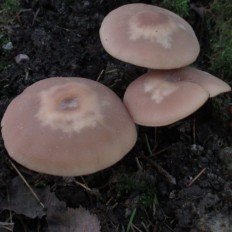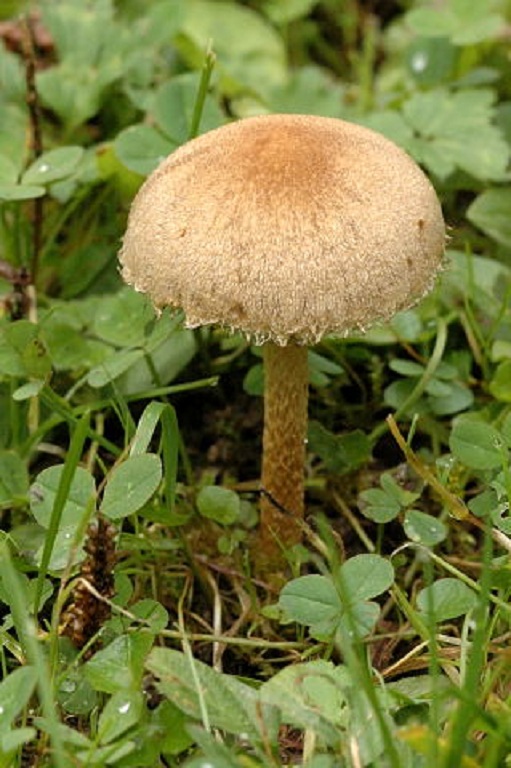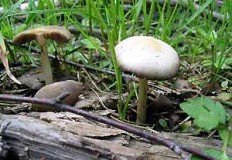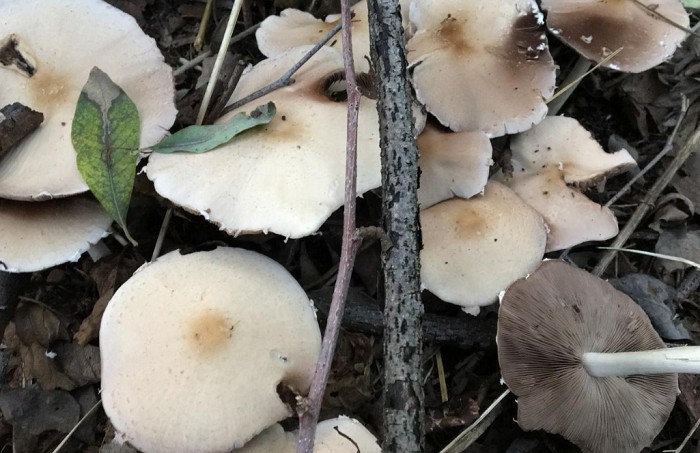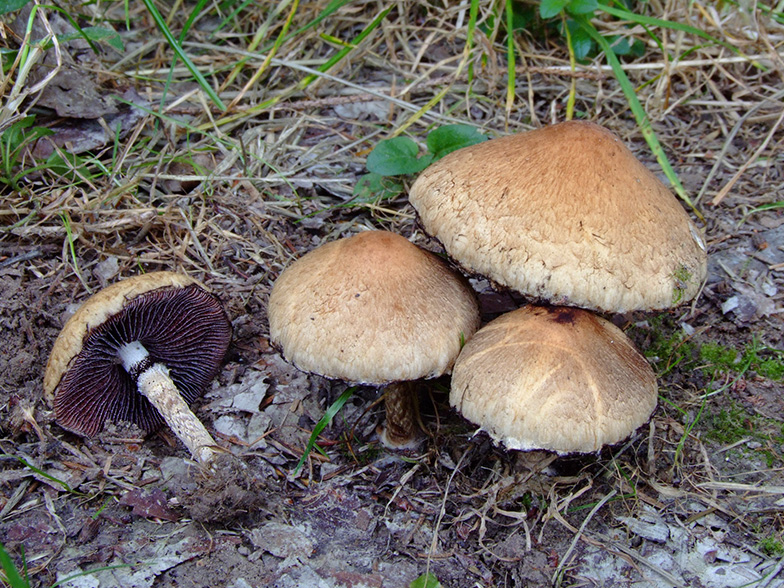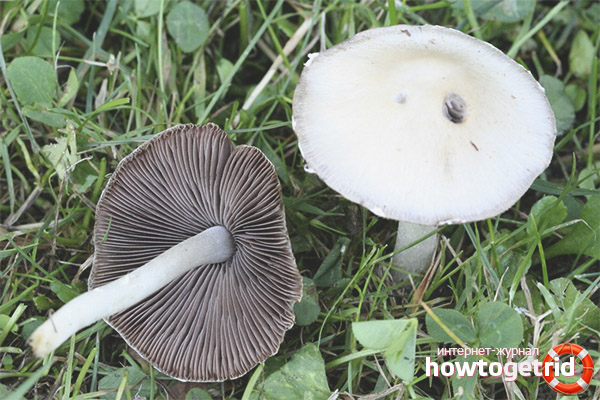Psathyrella cotonea

Oddly enough, I could not find a single description of Psathyrella cotonea, neither in paper nor in electronic form, although photographs are in bulk. So I will have to reconstruct the description of this mushroom based on my own impressions of a month ago and common sense.
Hat: 2-5 cm in diameter, conical or hemispherical at the beginning; with age, it opens almost to extended. The surface is mottled, heavily cracked (white flesh can be seen from under the darker top layer), which gives the mushroom a kind of "wadded" look. The color of the upper layer is brownish-gray (with a large tolerance in both directions), the lower one is white. White remnants of a private bedspread are visible along the edges of the cap. The pulp is relatively thick (especially for psatirella), white, with a very strong floral scent (linden blossom, lilac).
Plates: Frequent, light in youth, almost white, darkening with age.
Spore powder: Black purple.
Leg: Length 3-6 cm, thickness about 0.5 cm, cylindrical, tapering at the cap, white at the top, darker, scaly at the bottom.
Distribution: Unclear. I saw this mushroom for the first and last time at the beginning of October 2003, in an old dry spruce forest. It grows in a heap, similar in this respect to P. candolleana.
Similar species: Obviously not. Dark, small-scaled specimens can probably be confused with some lepiots, but the color of the spore powder unambiguously resolves the issue.
Edible: Unknown. On some obscure site, the name Psathyrella cotonea was mentioned in a psilocybin context, but I would not take this information seriously.
Author's notes: 2003 was the year of the mushroom parade. And it's not even about the volumes and not the centners per hectare. It's about variety. Sometimes it seems to me that I have not seen as many species in my entire life as this summer. And not only in summer - until late autumn in the forest, which I publicly declared barren and meaningless, all sorts of miracles grew.
Towards the middle of autumn, I began to avoid this spruce forest - in fact, nothing but blushing umbrellas (Macrolepiota rhacodes), thin forest mushrooms (Agaricus silvicola), bulbous spines (Leucocortinarius bulbiger), a row of water-spotted Lepista gilva, as well as some the most interesting variety of autumn mushroom was not there. However, the moment came when the mushrooms ended, and the blackies ended, and the waves ended, and the boletus were collected, and what to do next? I had to go to collect these unfortunate umbrellas.
Yes, I went and did not regret it. Because in addition to all sorts of food nonsense, I came across a herd of these small, fragrant, nothing like psatirells. That is, at first I did not even suspect that it was psatirella - I was very much puzzled. (Indeed, a coprophagous mushroom cannot smell of lime blossom!) Never, I thought, will never be able to unravel the mystery of this furry inhabitant of the bowels! As usual, I was wrong.
Interesting Facts
Previously, all psatirells were classified as dung beetles, but then mycologists separated them into a separate family. The name "psatirella" is formed by adding a diminutive suffix to the Latin term literally translated as "fragile", therefore these mushrooms are also called "fragile". In all psatirellas, the cap is hygrophane, that is, it has the ability to absorb moisture and thereby change its color. Psatirella is rarely edible (like psatirella is gray-brown, so this species is rather an exception). Not every mushroom picker is able to distinguish between the types of psatirella, so this mushroom does not cause much interest among collectors.
It should be remembered that even edible psatirella should not be included in the diet of children under 7 (according to some sources, even 12), pregnant and lactating women, as well as those suffering from chronic organic digestive disorders. In addition, mushrooms are a frequent allergen, so people with a tendency to hypersensitivity reactions are better off not eating mushrooms.
How to distinguish cotton psatirella
Psatirella cotton, like any forest dweller, has twins. These include:
- Velvety - belongs to the 4th group of edibility.You can recognize the species by the bell-shaped cap, which partially straightens as it grows. The surface is up to 8 cm in diameter, covered with a velvety skin of lemon-brown or light brown color. Cylindrical, slightly curved leg, 8-10 cm long, covered with dirty gray small scales. The pulp is fibrous, without a pronounced mushroom taste and smell. The fungus grows among deciduous trees, begins to bear fruit from July to September. Grows singly and in small families in well-lit glades.
- Globular - an inedible specimen that prefers to grow on stumps, damaged deciduous and coniferous wood. You can recognize the mushroom by its convex cream or coffee-colored hat. After the rain, the cap swells and grows in size. The whitish pulp is dense, fragile, without a pronounced taste and smell. The leg is hollow, slightly curved, reaches a height of 8 cm. Covered with light gray scales, and the upper part with a mealy bloom.
- Candolle - the species belongs to the 4th group of edibility. It can be recognized by a small bell-shaped hat of snow-white or lemon-brown color and a cylindrical whitish-coffee leg. The bottom layer of the cap is formed by gray plates adhered to the stem. The pulp is thin and fragile, has a pleasant mushroom smell and taste. This specimen grows in large families among deciduous trees, in forests, parks and squares. Begins fruiting from May to October.
Season and habitat of the mushroom
Fruiting of velvety psatirella (Psathyrella lacrymabunda) begins in July, when solitary mushrooms of this species appear, and its activity increases significantly in August and continues until early September.
From mid-summer to about October, velvety psatirella can be found in mixed, deciduous and open places, on soils (often sandy), in grass, near roadsides, on rotten wood, near forest paths and roads, in parks and squares, in gardens and cemeteries. It is not often possible to meet mushrooms of this type in Russia. Velvety psatirellas grow in groups or singly.
Psatirella Candolla
Hat (diameter 4-10 cm): cream or light brown, very fragile, over time it changes from a hemispherical or bell-shaped to almost spread. Young mushrooms of psatirella Candoll may have small brownish scales. The edges are wavy, covered with cracks; there is usually a small tubercle in the center.
Stem (height 4-11 cm): very smooth, usually white, occasionally brown. It has a slight thickening at the base and slight pubescence along its entire length. Like the hat, it is very fragile.
Plates: frequent and narrow, adhere tightly to the stem. Young mushrooms are light, old ones are dark brown.
Flesh: brittle, white. The subtle scent can only be felt at very close range.
Doubles: brown-gray psatirella (Psathyrella spadiceogrisea), which has a darker cap and does not grow in or near trees, but exclusively in the grass.
Application in traditional medicine: not applicable.
Other names: Candoll's pseudo-froth, Candoll's fragile girl.
The psatirella Candoll mushroom grows from late May to mid-October in the countries of the Eurasian continent and North America.
Where can you find it: on stumps, next to or on trees. Almost always found only in deciduous forests.
Eating: practically not consumed, as it requires complex heat treatment.
Description of psatirella Candoll
In young psatirella Candoll, the cap has a bell-shaped shape, over time it becomes relatively open, while a smooth slight elevation remains in the center. The diameter of the cap ranges from 3 to 7 centimeters. The color of the cap varies from white to yellow-brown. There are specific flakes along the edges of the cap, which are the remains of the bedspread.
The pulp is brittle, thin, whitish-brown in color. The pulp has a pleasant mushroom aroma.The plates of young fruiting bodies are grayish in color; as the fungus matures, they become darker and reach a dark brown color. The plates are densely planted, they grow to the stem.
Spore powder of purple-brown color, almost black. The leg is cylindrical, hollow, with a small fluff at the bottom. The color of the leg is whitish-cream. The leg length is 7-10 centimeters with a thickness of 0.4-0.8 centimeters.

Spread of Candoll's false-horns
These mushrooms bear fruit from May until autumn. They grow in deciduous and mixed forests, as well as in parks and gardens. You can find Candoll's psatirella on the stumps and roots of deciduous trees. They grow in numerous groups.
With the onset of summer, Candoll's false heaps begin to compete for territory with shimmering dung beetles. And the dung beetles win, they choose the sunny side, and Candoll's psatirella grows in the shade.
Edible psatirella Candoll
Psatirella Candolla in old sources was referred to as inedible and even poisonous species, but today it is believed that they can be eaten after long boiling, therefore they are classified as conditionally edible mushrooms.

Similarity to other mushrooms
A distinctive feature of Candoll's mushroom is the remains of the bedspread present on the edges of the cap. But sometimes the remains of the bedspread are not preserved, in this case Candolle's psatirella is distinguished from different types of mushrooms by the places of growth - the former grows on dead wood, in numerous groups. In addition, Candoll's mushroom does not have a clearly defined ring on the leg.
Psatirella Candolla differs from representatives of the genus Agrocybe in a darker color of spore powder. But it should be borne in mind that Candoll's mushrooms are very changeable mushrooms, they can have completely different colors, which depends on the temperature, humidity and places where the fruit chalk grows. However, Candoll's mushrooms are completely different from the popular, edible mushrooms.

Other mushrooms of this genus
Psatirella gray-brown has a spherical cap at a young age, but then it opens and becomes almost prostrate. The hat is small - 3-6 centimeters in diameter. In young mushrooms, the edges of the caps are covered with a fringe, which is the remnants of a bedspread.
In dry weather, the caps often crack. A small tubercle sometimes remains in the center of the cap, but it can be seen very rarely, as a rule, in thin-fleshy fruit chalk. The color of the cap is very variable, it depends on the weather conditions. In color, any shades of brown and gray can be observed. In dry weather, the cap generally fades and turns yellow. The height of the leg is 4-8 centimeters, and the diameter reaches 0.8 centimeters, which is quite a lot in comparison with other types of psatirella. The leg is flat, cylindrical, whitish in color, its surface is covered with scales.
Psatirella gray-brown begins to bear fruit in early May. These mushrooms grow on decaying wood. They settle in rather scattered groups, sometimes they can grow together with each other. Fruiting occurs in waves, the last stage is observed in mid-October. The fungus is an edible member of the genus.

Psatirella is water-loving, she is spherical psatirella has a cap with a diameter of 2-5 centimeters. The pulp is thin, watery, brown in color, with a bitter taste, without a pronounced odor.
Psatirella water-loving bears fruit from September to November. Inhabits the remains of deciduous wood, in a more rare case, it is found on needles. This is an inedible species.
As it grows, the cap changes from bell-shaped to almost flat, with a rounded tubercle in the central part and cracking edges. The skin is dry, smooth. The color of the cap is dark brown or yellow-brown. The length of the leg is 4-8 centimeters, with a diameter of 0.5-0.8 centimeters. The leg is hollow inside, often curved. The surface of the leg is silky, its lower part is light brown with a powdery coating of white.

Collection rules
Psatirella Candolla is highly variable: its external characteristics depend on the place of growth, air temperature during growth, soil composition, lighting and type of wood. Therefore, in different regions and even in different places, the mushroom has its own, unique appearance. It differs from the related inedible mushrooms of Candoll only in the presence of the remains of the bedspread and the shade of spores. This makes it very difficult to collect. Fruits brittle honey fungus in places with little shading, even on fairly dry soil in large groups, where about 1 kg of mushrooms can be collected at a time
In one place, the culture grows for 3 - 4 years, which is very important for mushroom pickers interested in collecting
Benefits and harm to the body
Psatirella Candoll does not represent any benefit to the human body, since it does not have any unique properties. It is not used in traditional medicine for medicinal purposes. False foams can be harmful due to improper cooking and non-observance of heat treatment regimes.
Poisoning is characterized by the following symptoms:
- dizziness and headache;
- nausea, heartburn, very unpleasant symptoms inside the stomach;
- vomiting, diarrhea;
- loss of consciousness;
- weakness, apathy and trembling limbs.
In some cases, if Candoll is poisoned with psatirella, loss of consciousness is possible. At the first symptoms, you should consult a doctor.
Description of psatirella globular
In young mushrooms, the shape of the cap is convex, hemispherical, sometimes bell-shaped, but as it grows, it opens and becomes half-open. There are often scraps of bedspreads along the edges of the cap. The diameter of the cap is small - from 2 to 6 centimeters. The structure of the cap is hygrophane, that is, it absorbs moisture. The color of the cap is very dependent on the humidity of the weather.
In rainy weather, the color of the hat is chocolate, and in dry weather it becomes creamy. The colors are often zoned.
The color of the flesh is whitish-cream. The pulp does not have a special taste and smell. The pulp is relatively tough, fragile, thin. The plates are adherent, often located, in young specimens of light color, but when the spores mature, the plates darken and turn dark brown. In damp weather, droplets of liquid may come out of the plates. The color of the spore powder is violet-brown.
The leg is smooth, although hollow inside, but rather dense. The height of the leg reaches 3-8 centimeters, with a thickness of no more than 0.7 cm. The color of the leg is whitish. There is a false ring at the top of the leg. Curved legs are common. The upper part of the leg is covered with a mealy bloom, and the lower part is light brown.

Spread of psatirella globular
These mushrooms grow on woody remains. They can be found on tree stumps in deciduous and coniferous forests, and near tree stumps in damp places. Spherical psatirella settle in large colonies, while uniting in bundles. Fruiting time lasts from June to October.
Edible psatirella globular
Psatirella globular is not considered a poisonous mushroom, but it is not considered edible either. It has no culinary value.
Similarity to other mushrooms
Psatirella globular differs from other representatives of the genus Psatirella in the brown color of the cap and in the places of growth.

Psatirella globular resembles gray-brown psatirella, but the latter is larger and grows less massively. The summer honey agaric also has a hygrophilous hat and a similar color, but there are quite a few differences in this case.
Bordered gallerina is a small brown fungus, which also has common features with globular psatirella, but the main difference is the color of the spore powder - in bordered gallerina it is rusty brown, and in psatirella, as noted, it is violet-brown.
Other mushrooms of the genus
Psatirella wadded has a conical cap at a young age, and with age it opens and reaches almost to the open.The cap is very cracked, and white flesh can be seen from under the dark skin, which makes the mushroom seem cottony.
The skin of the cap is brownish-gray. And the bottom of the hat is white. There may be remnants of a white blanket around the edges of the cap. The leg is cylindrical in shape, 3-6 centimeters high, with a width of 0.5 centimeters. The upper part of the leg is narrower, white in color, and darker at the bottom. The leg is covered with small scales.

Psatirella cotton is not very common. Typically, these mushrooms grow in dry spruce forests. They bear fruit around the middle of autumn. They settle in large numbers, in large groups. There is no information about the edibility of the Pasatirella, most likely it is classified as an inedible species.
Psatirella Candolla or Candoll's pseudofoam has a bell-shaped cap at a young age, then it becomes relatively open with a small tubercle in the center. The diameter of the cap is 3-7 cm. The color of the cap varies from white to yellow-brown.
White flakes hang around the edges of the cap - the remains of the bedspread. The leg is cylindrical, hollow, slightly pubescent in the lower part. The color of the leg is whitish-cream. Its length is 7-10 centimeters with a thickness of 0.4-0.8 centimeters.
Psatirella Condole bears fruit from May to early autumn. These mushrooms grow in mixed and deciduous forests, settling mainly on stumps and roots of deciduous trees. They grow in large groups. In old sources, these mushrooms appear as inedible and even poisonous, but in modern literature they are considered quite edible mushrooms that need preliminary boiling.


